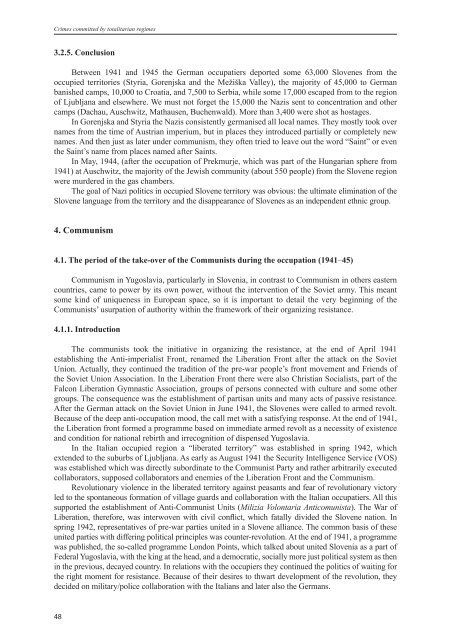crimes committed by totalitarian regimes - Ministrstvo za pravosodje
crimes committed by totalitarian regimes - Ministrstvo za pravosodje
crimes committed by totalitarian regimes - Ministrstvo za pravosodje
Create successful ePaper yourself
Turn your PDF publications into a flip-book with our unique Google optimized e-Paper software.
Crimes <strong>committed</strong> <strong>by</strong> <strong>totalitarian</strong> <strong>regimes</strong><br />
3.2.5. Conclusion<br />
Between 1941 and 1945 the German occupatiers deported some 63,000 Slovenes from the<br />
occupied territories (Styria, Gorenjska and the Mežiška Valley), the majority of 45,000 to German<br />
banished camps, 10,000 to Croatia, and 7,500 to Serbia, while some 17,000 escaped from to the region<br />
of Ljubljana and elsewhere. We must not forget the 15,000 the Nazis sent to concentration and other<br />
camps (Dachau, Auschwitz, Mathausen, Buchenwald). More than 3,400 were shot as hostages.<br />
In Gorenjska and Styria the Nazis consistently germanised all local names. They mostly took over<br />
names from the time of Austrian imperium, but in places they introduced partially or completely new<br />
names. And then just as later under communism, they often tried to leave out the word “Saint” or even<br />
the Saint’s name from places named after Saints.<br />
In May, 1944, (after the occupation of Prekmurje, which was part of the Hungarian sphere from<br />
1941) at Auschwitz, the majority of the Jewish community (about 550 people) from the Slovene region<br />
were murdered in the gas chambers.<br />
The goal of Nazi politics in occupied Slovene territory was obvious: the ultimate elimination of the<br />
Slovene language from the territory and the disappearance of Slovenes as an independent ethnic group.<br />
4. Communism<br />
4.1. The period of the take-over of the Communists during the occupation (1941–45)<br />
Communism in Yugoslavia, particularly in Slovenia, in contrast to Communism in others eastern<br />
countries, came to power <strong>by</strong> its own power, without the intervention of the Soviet army. This meant<br />
some kind of uniqueness in European space, so it is important to detail the very beginning of the<br />
Communists’ usurpation of authority within the framework of their organizing resistance.<br />
4.1.1. Introduction<br />
The communists took the initiative in organizing the resistance, at the end of April 1941<br />
establishing the Anti-imperialist Front, renamed the Liberation Front after the attack on the Soviet<br />
Union. Actually, they continued the tradition of the pre-war people’s front movement and Friends of<br />
the Soviet Union Association. In the Liberation Front there were also Christian Socialists, part of the<br />
Falcon Liberation Gymnastic Association, groups of persons connected with culture and some other<br />
groups. The consequence was the establishment of partisan units and many acts of passive resistance.<br />
After the German attack on the Soviet Union in June 1941, the Slovenes were called to armed revolt.<br />
Because of the deep anti-occupation mood, the call met with a satisfying response. At the end of 1941,<br />
the Liberation front formed a programme based on immediate armed revolt as a necessity of existence<br />
and condition for national rebirth and irrecognition of dispensed Yugoslavia.<br />
In the Italian occupied region a “liberated territory” was established in spring 1942, which<br />
extended to the suburbs of Ljubljana. As early as August 1941 the Security Intelligence Service (VOS)<br />
was established which was directly subordinate to the Communist Party and rather arbitrarily executed<br />
collaborators, supposed collaborators and enemies of the Liberation Front and the Communism.<br />
Revolutionary violence in the liberated territory against peasants and fear of revolutionary victory<br />
led to the spontaneous formation of village guards and collaboration with the Italian occupatiers. All this<br />
supported the establishment of Anti-Communist Units (Milizia Volontaria Anticomunista). The War of<br />
Liberation, therefore, was interwoven with civil conflict, which fatally divided the Slovene nation. In<br />
spring 1942, representatives of pre-war parties united in a Slovene alliance. The common basis of these<br />
united parties with differing political principles was counter-revolution. At the end of 1941, a programme<br />
was published, the so-called programme London Points, which talked about united Slovenia as a part of<br />
Federal Yugoslavia, with the king at the head, and a democratic, socially more just political system as then<br />
in the previous, decayed country. In relations with the occupiers they continued the politics of waiting for<br />
the right moment for resistance. Because of their desires to thwart development of the revolution, they<br />
decided on military/police collaboration with the Italians and later also the Germans.<br />
48




